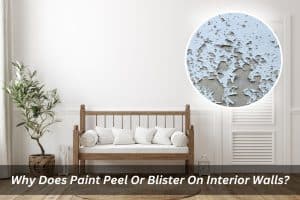
Painting your interior walls can transform the look and feel of your home, but the frustration of seeing paint peel or blister can quickly dampen the excitement. Understanding why this happens is crucial for maintaining a pristine interior. In this article, we’ll delve into the signs, causes, prevention methods, and solutions for paint peeling or blistering on interior walls.
What are the signs of paint peeling or blistering?
Before diving into the causes, let’s identify the telltale signs that your once flawless paint job is succumbing to peeling or blistering. These signs often include patches where the paint has lifted from the wall, forming bubbles or cracks. You may notice a rough texture or uneven surface, signalling the need for investigation and action.
What are the causes of peeling and blistering paint on interior walls?
Understanding the root causes is essential for effective prevention and repair. Several factors contribute to paint peeling or blistering on interior walls:
- Moisture issues: One of the primary culprits is moisture infiltration. Water can seep through walls, either from leaks, high humidity levels, or inadequate ventilation. The moisture disrupts the bond between the paint and the wall surface, leading to peeling or blistering.
- Poor surface preparation: Rushing through the preparation phase can come back to haunt you. Failing to clean, sand, and prime the surface properly hinders the paint’s ability to adhere, resulting in premature peeling.
- Low-quality paint: Investing in high-quality paint is a wise decision. Inferior paints lack the durability and adhesion properties necessary for a long-lasting finish. Before starting your next paint project, consider the quality of the paint you choose.
- Incompatible coatings: Mixing incompatible paint types or applying a new coat before the previous one has cured can lead to chemical reactions, causing blistering. Always follow the manufacturer’s recommendations regarding compatibility and drying times.
- Extreme temperatures: Fluctuations in temperature can wreak havoc on painted surfaces. Extreme heat or cold can cause the paint to expand and contract, leading to cracks and eventually peeling.
- Substrate movement: The natural movement of the building, such as settling or shifting, can affect the paint’s integrity. Cracks in the walls or foundation can transfer to the paint surface, resulting in peeling over time.
How can you prevent peeling and blistering paint on interior walls?
Prevention is the key to maintaining a flawless interior paint job. Here are some practical tips to keep your walls looking fresh:
- Address moisture issues: Regularly inspect your home for leaks and fix them promptly. Ensure proper ventilation in areas prone to high humidity, such as kitchens and bathrooms. Consider using moisture-resistant paint in these areas.
- Thorough surface preparation: Take the time to prepare the surface adequately before painting. Clean the walls, remove any existing peeling paint, or sand imperfections, and apply a suitable primer. Proper preparation sets the foundation for a long-lasting paint job.
- Choose quality paint: Consider sustainable wall solutions by selecting high-quality paints from reputable brands. These paints not only provide superior adhesion, durability, and resistance to environmental factors but also contribute to a more resilient finish.
- Follow manufacturer recommendations: Always follow the manufacturer’s guidelines for paint application. This includes proper mixing, drying times, and compatibility with other coatings. Ignoring these recommendations can lead to avoidable issues.
- Control temperature and humidity: If possible, avoid painting in extreme weather conditions. Ideally, paint during mild temperatures to minimise the impact of temperature-related stress on the paint.
How can you repair paint peeling or blistering?
If you find your walls already showing signs of peeling or blistering, it’s not the end of the world. Here’s how you can address the issue:
- Remove loose paint: Start by carefully scraping off any loose or peeling paint using a putty knife or scraper. Be thorough, ensuring that you create a smooth surface for the new paint.
- Sand the surface: Once the loose paint is removed, sand the surface to create a smooth and even base. This step promotes better adhesion for the new paint.
- Prime the surface: Apply a high-quality primer to the repaired area. Primer not only enhances adhesion but also seals the surface, preventing future issues.
- Choose the right paint: When selecting paint for touch-ups, ensure it matches the existing colour and finish. This consistency will create a seamless look and prevent the need for repainting entire walls.
- Apply a topcoat: Once the primer has dried, apply a topcoat of paint. Feather the edges to blend the new paint with the surrounding area, ensuring a uniform appearance.
How can you maintain your paint job to prevent future problems?
Maintaining your interior paint job goes beyond the initial application. Follow these tips to ensure the longevity of your walls:
- Regular inspections: Periodically inspect your walls for any signs of damage or wear. Catching issues early allows for timely repairs and prevents more extensive problems.
- Clean with care: When cleaning painted surfaces, use mild detergents and avoid abrasive materials. Harsh cleaning agents can damage the paint, leading to peeling or blistering.
- Address leaks promptly: If you notice any water leaks, address them immediately. Water damage is a primary contributor to paint problems, and swift action can prevent extensive damage.
- Maintain proper ventilation: Adequate ventilation is crucial, especially in areas prone to high humidity. Use exhaust fans in bathrooms and kitchens to reduce moisture levels.
- Protect walls from physical damage: Be mindful of furniture, pets, and other potential sources of physical damage. Use protective measures such as furniture pads to prevent scratches and dents.
Conclusion
Understanding why paint peels or blisters on interior walls empowers you to take proactive measures for prevention and timely repairs. By addressing issues such as moisture, and poor surface preparation, and using high-quality materials, you can enjoy a beautiful and durable interior paint job. Regular maintenance and swift action in the face of emerging problems will keep your walls looking pristine for years to come.
Are you experiencing the frustration of peeling or blistering paint on your interior walls? At SCP Painting, we understand the importance of a flawless paint job in transforming your home. Our expert team is equipped to address the root causes of paint issues, from moisture control to meticulous surface preparation. Choose quality with SCP Painting, ensuring that our high-grade paints and professional application techniques stand the test of time. Whether you’re looking to refresh your current paint job or prevent future problems, our services are tailored to meet your needs. Don’t let paint problems linger—take action today and trust SCP Painting for a long-lasting and impeccable interior finish. Your home deserves the best, and SCP Painting is here to deliver. Contact us now for a consultation and let us bring vibrancy back to your living spaces.

